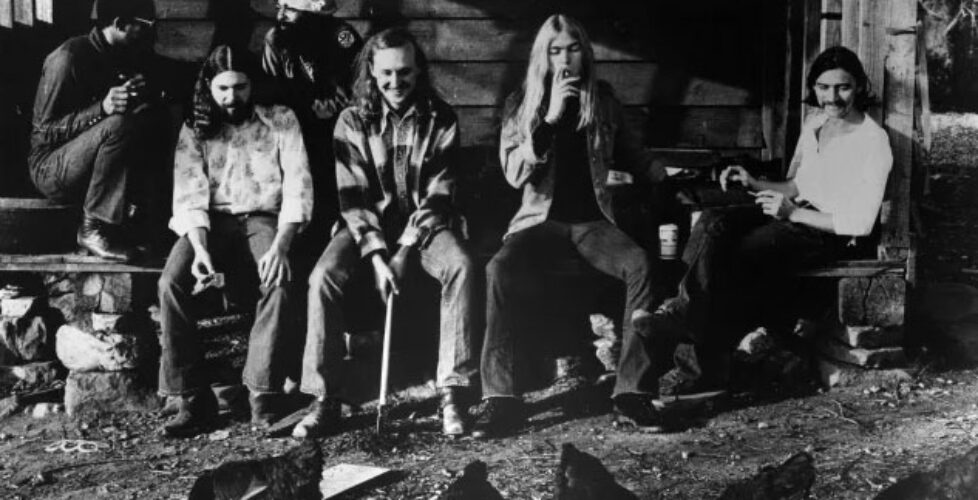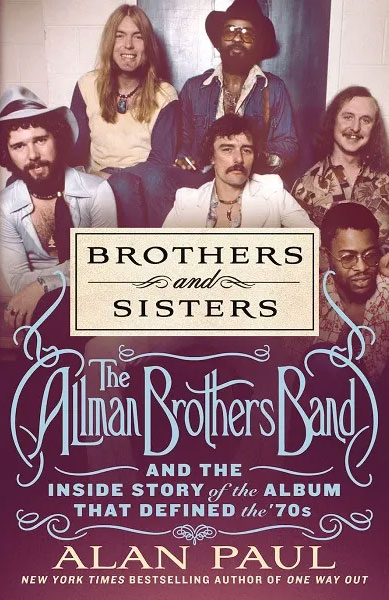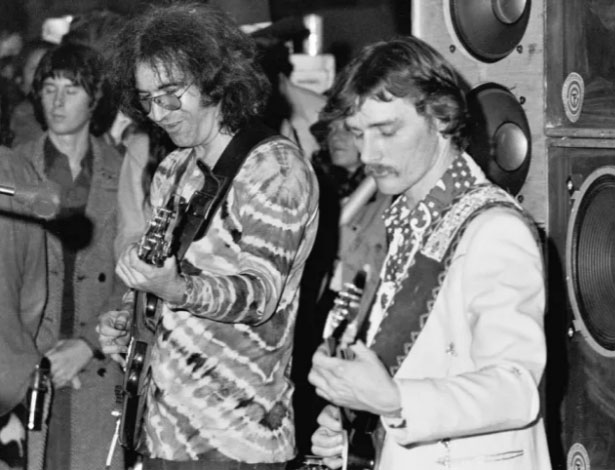How The Allman Brothers Went From Disaster To Stadium Kings

‘Brothers and Sisters,’ a new book from Alan Paul, explains how 50 years ago the Allman Brothers Band came back from tragedy to create the chart topping album that would make them one of the defining sounds of the ’70s.
In their tumultuous 45-year career, the founding members of the Allman Brothers Band let precisely two music journalists gain their trust. The first was writer/director Cameron Crowe, who toured with the band in 1973, as a 16-year-old on assignment from Rolling Stone, and decades later his sweet memories formed part of his movie Almost Famous. The second is Alan Paul, now 56, a writer and musician who slowly – over two decades writing for the underdog music magazine Guitar World – won the confidence of the core members: taciturn bluesman Gregg Allman, ornery guitar genius Dickey Betts, grumpy drummer Butch Trucks, and serene philosopher/percussionist Jaime Johanson. (Only Betts and Jaimoe are still alive today.) Paul became the band’s unofficial historian, writing the 2014 bestseller One Way Out: The Inside History of the Allman Brothers Band. He also launched an Allmans tribute band, Friends of the Brothers, stocked with former Gregg and Dickey sidemen. Now he’s back with Brothers and Sisters: The Allman Brothers Band and the Inside Story of the Album That Defined the ’70s (St. Martin’s Press). His book tour has a backup band.
Quibble you may with the tail end of Paul’s subhead — Brothers and Sisters was the Allman Brothers fourth studio album, released 50 years ago, in August of 1973, and “Ramblin’ Man” aside few would argue it was a decade defining moment — but there’s no doubt this is one hellacious inside story, a wild ride through early-70s America, when the counterculture begat arena rock. By July 1971, when the Allman Brothers released their breakthrough live album At Fillmore East, Bill Graham had closed that fabled New York venue because it wasn’t big enough to hold all the customers. On October 29, the Brothers’ charismatic leader, slide guitarist Duane Allman, cashed the first substantial royalty check of his life, then spun out his Harley trying to avoid a truck and died at age 24. A year after that Duane’s heartbroken friend and deputy bandleader, bass player Berry Oakley, crashed his own motorbike into a bus and was buried beside Duane. Stupefied by grief and narcotics, the surviving Brothers very nearly dissolved.

Their musical resurrection may seem inevitable now — or as overly familiar as the opening lick of “Ramblin’ Man.” But Paul’s deep, careful reporting across the decades (along with a trove of never-heard band interviews from the late 1980s conducted by longtime ABB tour manager/archivist Kirk West) makes it all feel raw and new, revealing the pain and precariousness of the Brothers and Sisters sessions. Gregg Allman, who had barely survived an overdose on the night his brother died, tried to beat back the darkness by focusing on his first solo album, the mournful Laid Back, which featured little lead guitar, instead showcasing a free-ranging young Georgia pianist named Chuck Leavell. It was Dickey Betts who rallied and reconfigured the Brothers as a one-guitar band — replacing Duane would have been unthinkable — but Dickey balked when Gregg suggested hiring Leavell for the Allman Brothers. Betts called him “Chopin” and stayed aloof until they jammed together and Betts realized Chopin could read his mind. Soon Leavell and Betts were the band’s twin leads, and a new Allmans era was born. (Cue the Betts instrumental “Jessica.”)
Paul admires the way Betts stepped up as the unlikely leader despite dark moods and a “mighty temper” he tried to keep in check by studying Zen Buddhism and karate. Betts learned Duane’s monster slide parts with ease, came into his own as a songwriter and singer just in time for Brothers and Sisters, lightened the band’s sound with a dose of country, and refined his own immediately recognizable guitar style featuring a bright, liquid tone and ecstatic, major-key lead lines that owed a debt to Jerry Garcia of the Grateful Dead. Brothers and Sisters sold more than 7 million copies and “Ramblin’ Man” ruled the radio. The Brothers played arenas and stadiums, headlining (with the Dead and the Band) the largest gathering in U.S. concert history, which drew 600,000 muddy celebrants to a racetrack in Watkins Glen, NY, 50 years ago this week. That crowd included thirty percent of all 17-to-24-year-olds living between New York and Boston at the time, according to an estimate cited by Paul. The hippies had taken the suburbs.
Paul’s book hits all the bases his story requires: Gregg marries Cher; Cher divorces Gregg. The band plays benefits to raise early money for Jimmy Carter’s upstart presidential campaign. Dickey trashes hotel rooms and kicks asses. (Much later, he would be thrown out of the band, which played on without him for another 14 years). And, in 1976, Gregg testifies against an Allman Brothers crew member at the man’s drug trial; the rest of the band publicly denounces Gregg. The Brothers break up for the first of many times and Paul’s time capsule snaps shut.

Happily, Paul is far more interested in music than gossip, and has a knack for writing about the way it sounds and how it makes people feel. He’s at his best tracking influences, dispelling myths and half-truths, and teasing out similarities and differences between players. Duane and Jerry Garcia were charismatic leaders who developed a tight bond, for example, but Betts and Garcia were kindred musical spirits. “I was studying the Dead before I ever made a record,” Betts told Paul in 2001. “Garcia influenced me a lot. I was trying to play electric rock guitar that incorporated some of the old-time acoustic melodies, and when I heard Garcia I felt like he had beat me to it.” Garcia tipped his hat in return, telling Betts early on that the Brothers had “caught up” to the Dead. Betts had his sound crew study Garcia’s rig to learn the secrets of his pristine tone, and the two jammed together every chance they got in 1972 and 1973. They got plenty of chances, most captured for posterity by audience tapers. (Hear them on the below cover of Dylan’s “It Takes A Lot To Laugh, It Takes a Train To Cry” from the final hour of a legendary Dead/Allman marathon on June 10, 1973 at RFK Stadium in Washington, DC, recently released in glorious sound from the Dead’s vault).
Betts was the louder, more aggressive player, Garcia the more searching, cerebral and drawn to musical discord. Betts told Paul that unlike the Dead, the Allmans had no patience for noodling: “We don’t wait for it to happen; we make it happen.” The night before Watkins Glen, however, the Dead proved again that patient group improvisation was their superpower, treating 150,000 early arrivals to a two-hour soundcheck that Paul calls “a signature epic performance that has resonated for half a century.” Deadheads will tell you they channeled music they hadn’t yet written, and it’s true. The Allmans felt the pressure and played for two hours as well.
When Betts and Garcia jammed together, it was never a cutting contest — their guitars tease and twine with the sort of melodic interplay Betts dearly missed with Duane. The finest example may be from San Francisco on December 31, 1973, when Garcia sat in at the Brothers’ New Year’s Eve show, playing gorgeous duets with Betts until 4 a.m. After that, the two men never again shared a stage and no one — not even Alan Paul — can quite explain why.
Let the mystery be, and thank a taper. We still have this music.
